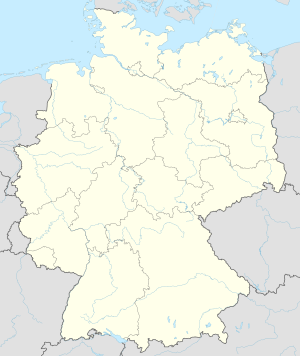Feldchenbahnbrücke
Coordinates: 51 ° 29 ′ 48 ″ N , 7 ° 33 ′ 6 ″ E
| Feldchenbahnbrücke | ||
|---|---|---|
| West side (2011) | ||
| use | Connecting railway , today a footpath and bike path | |
| Convicted | Verbindungsbahn Aplerbeck - colliery Schürbank & Charlottenburg | |
| Subjugated | Emscher | |
| place | Aplerbeck | |
| construction | Arch bridge in brick | |
| overall length | 25 m | |
| width | 5 m | |
| Number of openings | 5 | |
| opening | 1870 | |
| closure | Connection railway : 1925 | |
| location | ||
|
|
||
The Feldchenbahnbrücke near the Dortmund district Aplerbeck is under preservation properties (Memorial number A 0407) in a Brick executed arch bridge . It represents the last surviving relic of the connecting line built between 1867 and 1870 from the United Schürbank & Charlottenburg colliery to the Dortmund – Soest line. The 1,600-meter-long, single-track railway line, which was about 100 meters west of the Aplerbeck station in the main line until it was closed almost formed an S shape. From the mine, the Feldchenbahnbrücke bridges the still very young at this point to over 700 meters Emscher .
history
In 1867, the Royal Direction of the Bergisch-Märkische Eisenbahn in Elberfeld, as the state supervisory authority for the Dortmund – Soest railway line built and operated by the Bergisch-Märkische Eisenbahn-Gesellschaft , sought permission from the Royal Prussian Government in Arnsberg to build a connecting line from Aplerbeck station to the United Schürbank & Charlottenburg colliery. As part of the construction of the route, renovation work also took place in the area of the Aplerbeck train station in 1869. In the year the line was completed (1870), the colliery facility was also extensively converted. With its closure in 1925, the use of the pure freight train route was also discontinued. After the superstructure was dismantled ( track bed and tracks ), the local residents used the dam and especially the bridge to cross the Emscher on foot or by bike.
In 2003, the city of Dortmund made efforts to demolish the bridge, which is owned by Essener Montan-Grundstücksgesellschaft, in spite of its protection as a monument, on the grounds that there is a risk of collapse. After negotiations between the city of Dortmund and the owner, a free transfer to the municipality was finally agreed, plus a grant from the property company of 50,000 euros to the total costs of the bridge renovation of 140,000 euros. The district government in Arnsberg contributed 60,000 euros, the remaining 30,000 euros from the city of Dortmund. From June 2005, under the supervision of the Lower Monument Authority , the renovation was carried out over a period of twelve weeks, primarily with a view to traffic safety. After the wild growth had been removed, the joints were cleaned and refilled. The stones needed to restore the arches could be obtained after a long search in the Münsterland; the ceiling of the bridge structure was covered with reinforced concrete slabs to protect against moisture.
description
The five-arch bridge structure has a length of around 25 meters and a total width of around five meters. The middle arch, also the largest, spans the Emscher. By the left and right of this lying arches lead economic way through. The outermost are unused and partially overgrown. So-called oculi are arranged in the spandrels of the barrel vault . The openings that are now closed were primarily used for ventilation, but also enhanced the overall aesthetic impression of the building. In such structures, behind the oculi, there are channels for draining off the penetrating water via the respective center of the arch.
See also
literature
- Volker Rödel: Cultural monuments in Hessen. Railway in Hessen. Part I. Railway history and building types 1829–1999. Edited by the State Office for Monument Preservation Hessen, Wiesbaden 2005, ISBN 3-8062-1917-6 , pp. 231–237.
- Thomas Vährmann, Susanne Brockfeld, Michael Funk (edit.): Sources on the history of the railway in the northern Rhineland, in Westphalia and Lippe from the beginnings to 1880. (= publications of the state archives of North Rhine-Westphalia. Series C: Sources and research Volume 42. ) Ed. North Rhine-Westphalian Main State Archive and North Rhine-Westphalian State Archive Münster, Respublica-Verlag, Siegburg 1998, ISBN 3-87710-184-4 (Part 1), p. 528 (evaluated source: State Archive Münster, holdings government Arnsberg, No. 21674).
Web links
Individual evidence
- ↑ a b Thomas Vährmann, Susanne Brockfeld, Michael Funk (arr.): Sources on the history of the railroad in the northern Rhineland, Westphalia and Lippe from the beginning until 1880.
- ↑ a b mass according to http://www.tim-online.nrw.de/
- ^ Wilhelm and Gertrude Hermann: The old collieries on the Ruhr (series: The Blue Books ). Verlag Langewiesche Nachhaben, Königstein im Taunus, 6th edition 2008, ISBN 978-3-7845-6994-9 , p. 174.
- ↑ Feldchenbahn Bridge (2003–2005). from aplerbeck-damals.de, accessed on January 10, 2014. digital
- ^ Volker Rödel: Cultural monuments in Hessen. Railway in Hessen. Part I. Railway history and building types 1829–1999. Ed. State Office for Monument Preservation Hessen, Wiesbaden 2005, ISBN 3-8062-1917-6 , p. 236 f.







